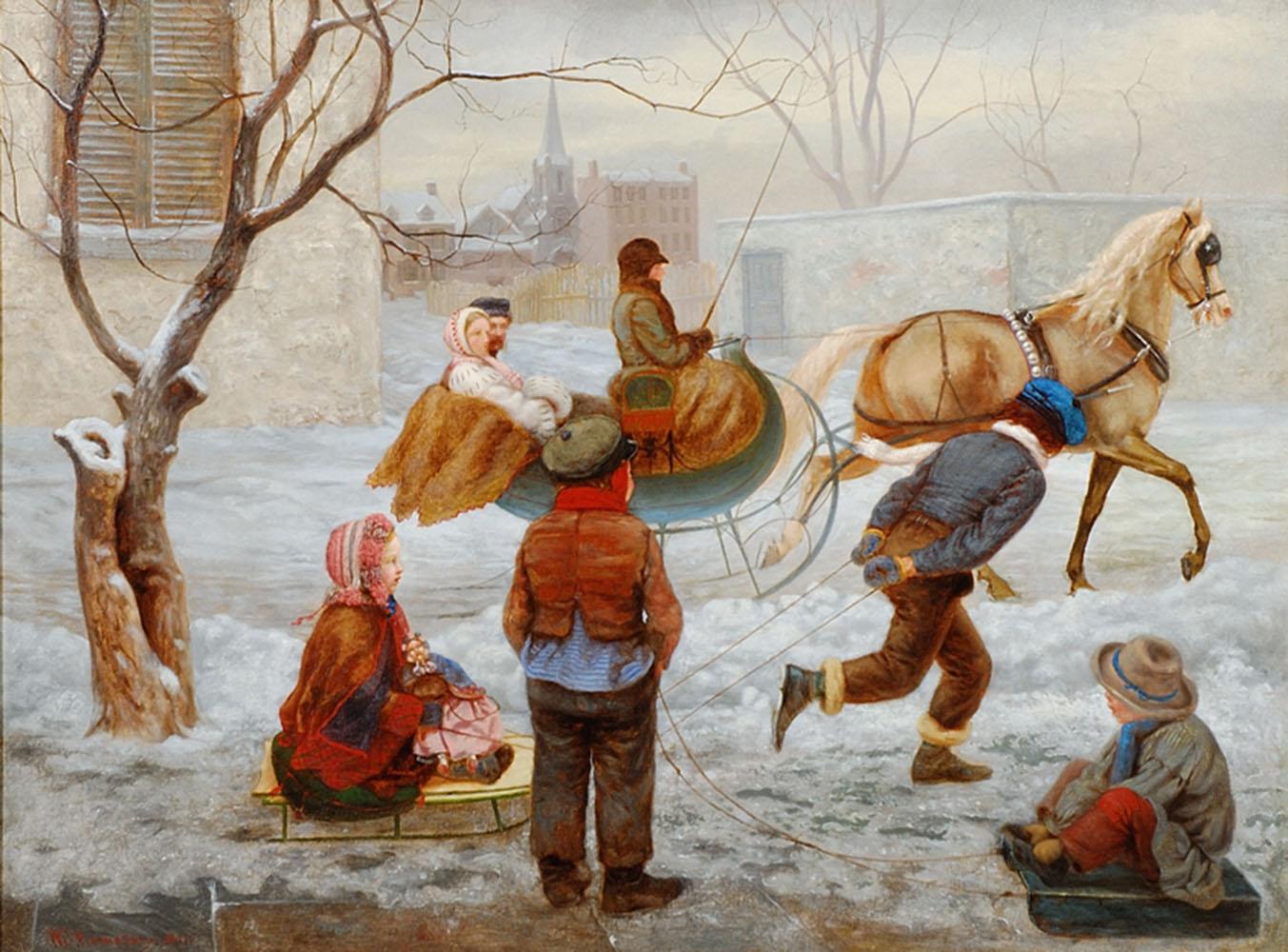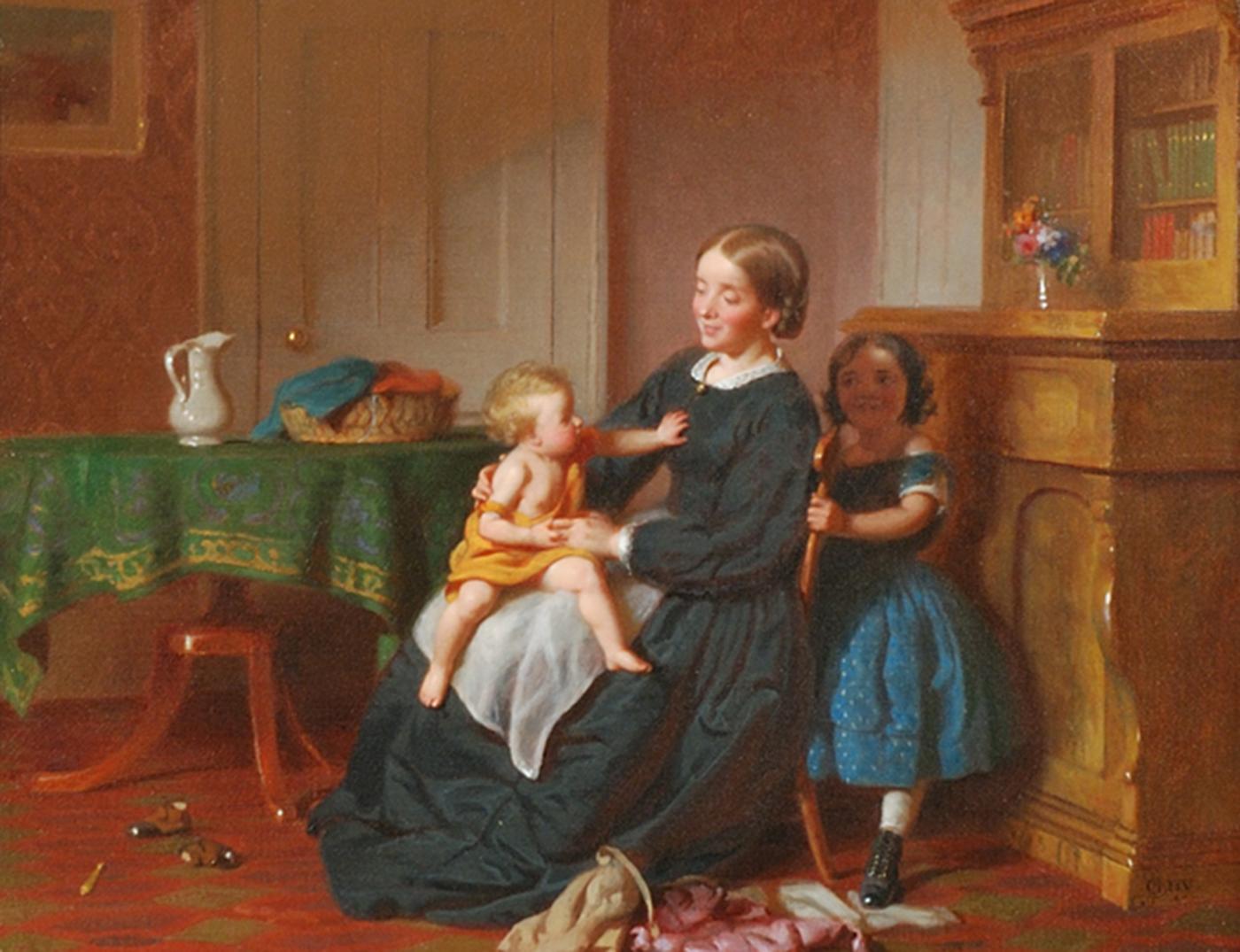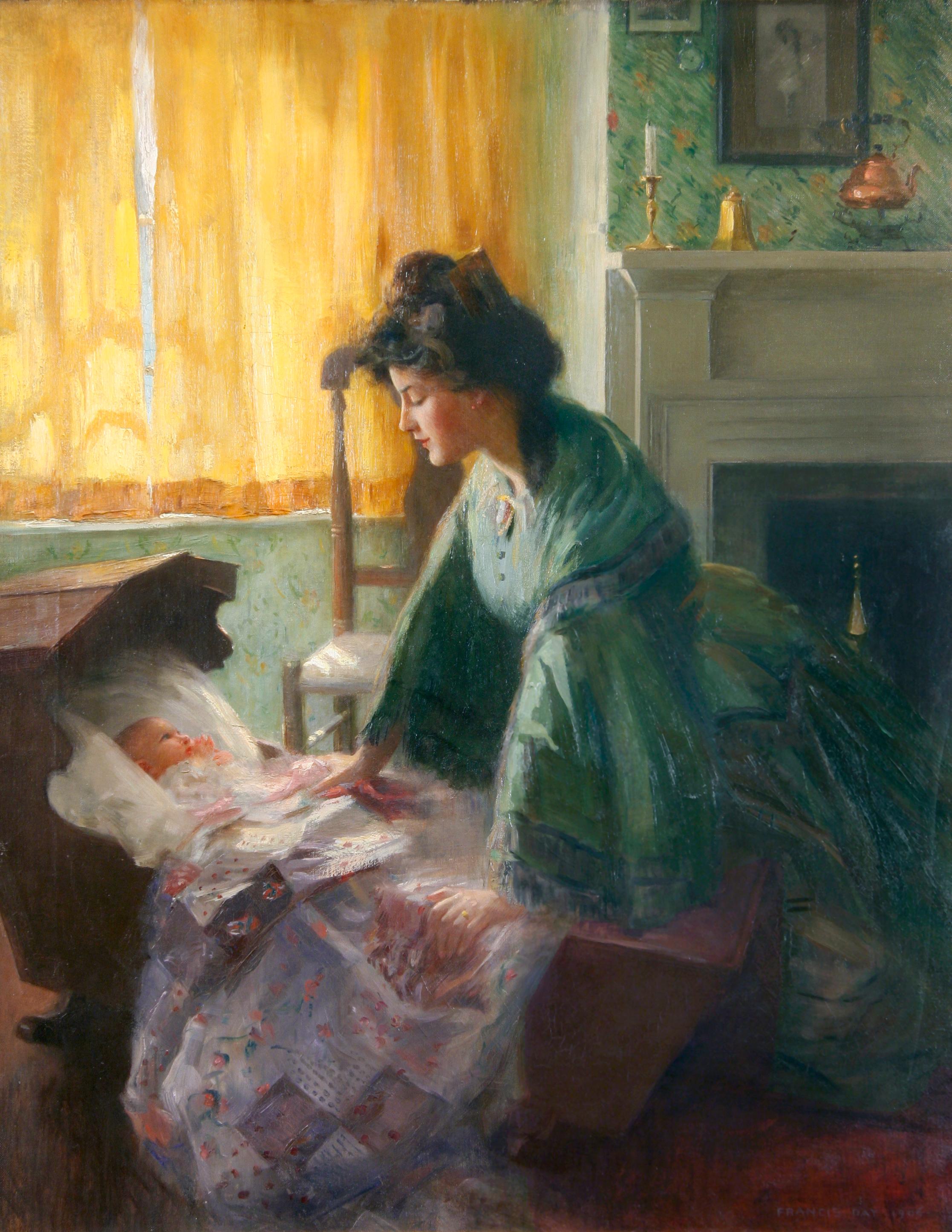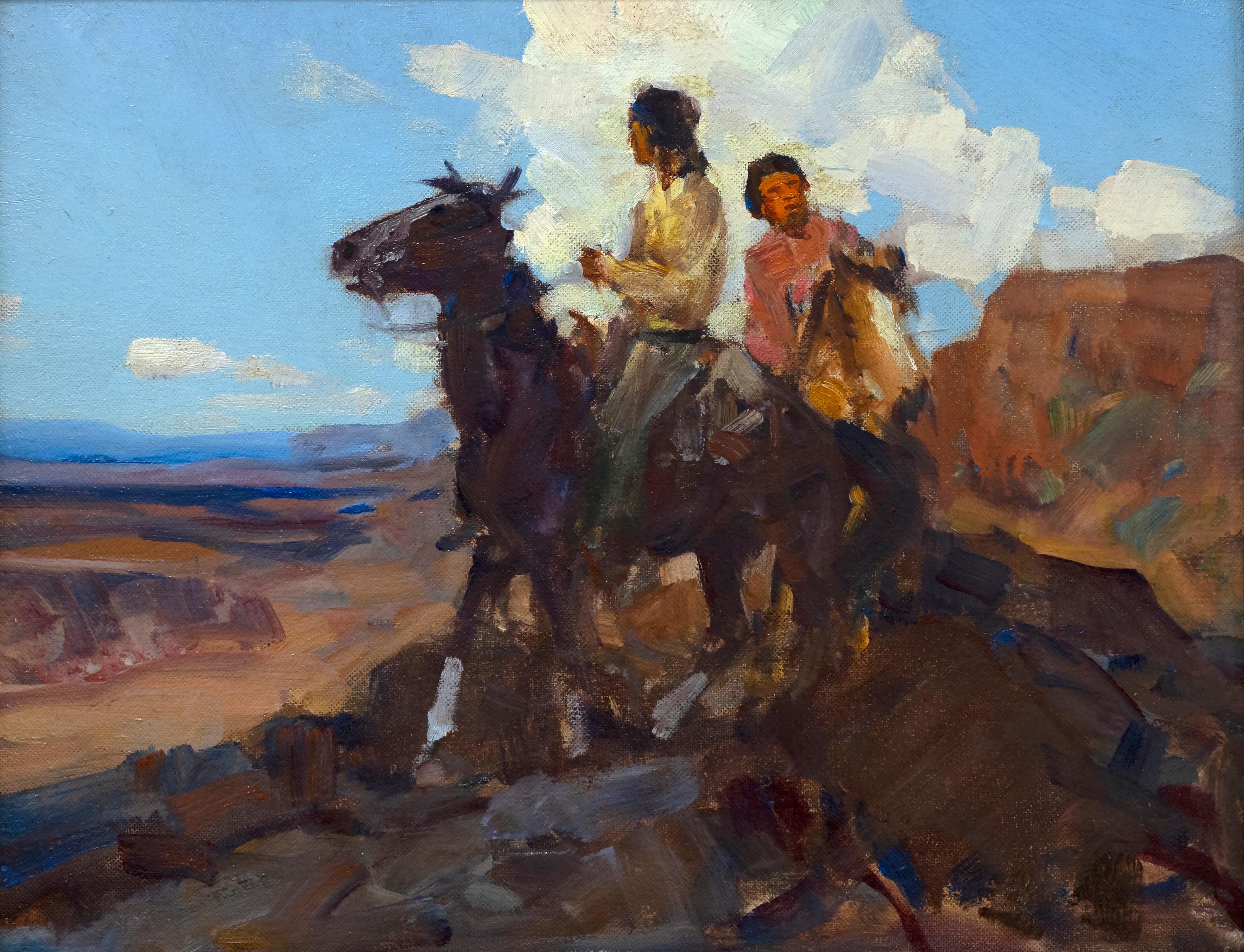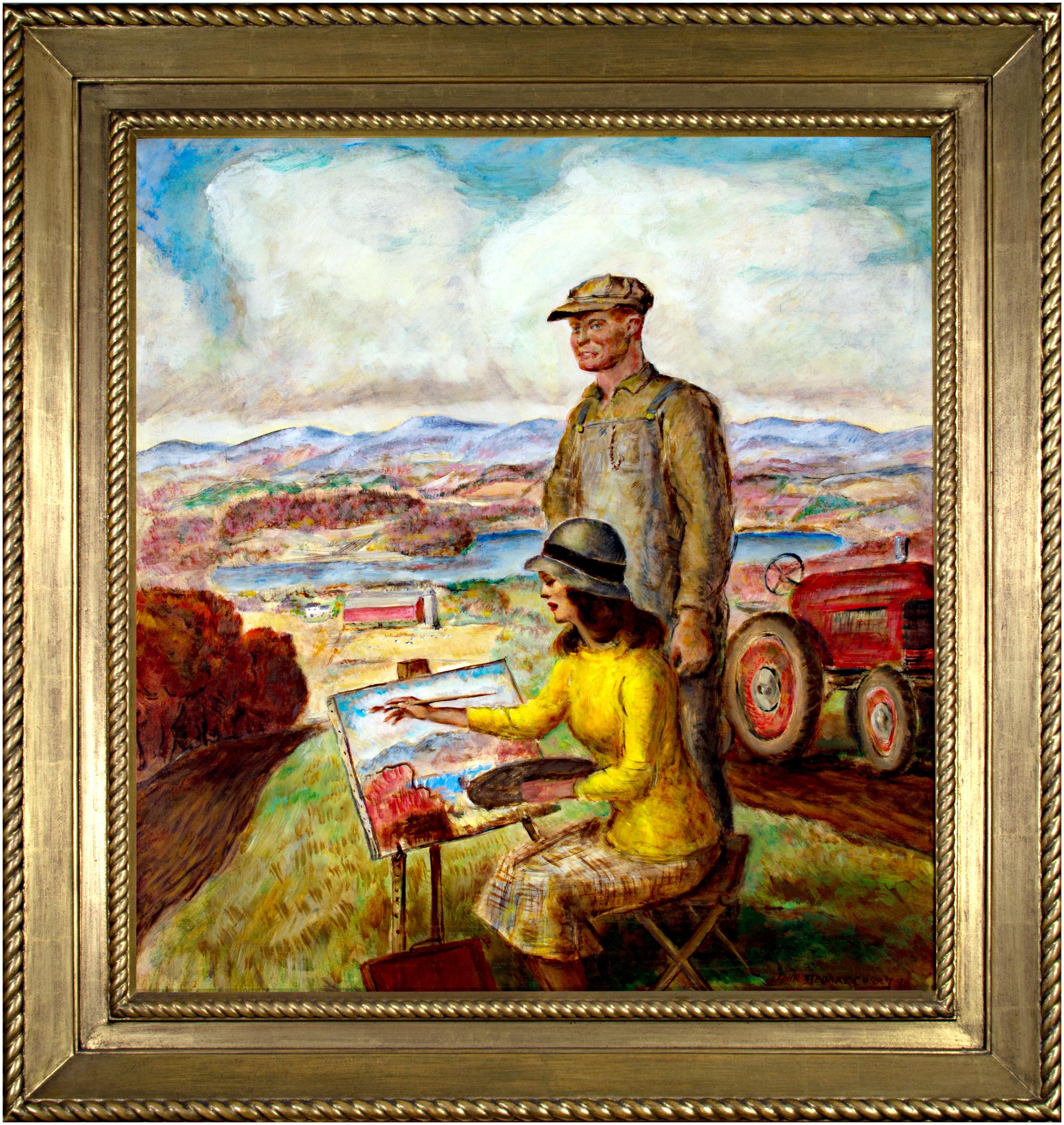Items Similar to Band Of Street Urchins (Charles Dickens) Large Oil Painting
Want more images or videos?
Request additional images or videos from the seller
1 of 6
Barry Leighton-JonesBand Of Street Urchins (Charles Dickens) Large Oil Painting
About the Item
Genre: Other
Subject: People
Medium: Oil
Surface: Canvas
Country: United Kingdom
Dimensions: 48" x 36" x 3/4"
Dimensions w/Frame: 48 3/4" x 37"
Barry Leighton-Jones was born in London, England in 1932 and is a direct descendant of the Victorian artist and President of the Royal Academy, Lord Frederic Leighton. He began his artistic career at the age of five by winning a major art competition, and later completed seven years of academic training at Sidcup and Brighton and was tutored by the acclaimed English artist and illustrator from the Royal College of Art - John Minton.
After launching himself straight into the British art world, his paintings were very quickly in demand - many of them were published and his international reputation grew. But the real breakthrough came in 1985, when he was selected by the Kelly Estate to create a series of images based on the life and work of the famous American clown - Emmett Kelly.
Taking a page out of Norman Rockwell's book, Leighton-Jones devoted a great amount of time to the preparation stage more than ever before. The Kelly Estate supplied Leighton-Jones with black and white photographs of Kelly throughout his career, and he took it upon himself to carefully study Kelly's work on film and read everything about the great man. He even completed visits to the Ringling Museum in Sarasota. All this preparation paid off, as the result is the comprehensive series of paintings, which join the different periods of Kelly's life. Many of the paintings and sketches were produced as limited edition prints and figurines, all becoming best sellers and eagerly sought after by collectors all over the U.S.A.
The years between 1986 and 1992 define one of the most important and prolific periods in the career of Barry Leighton-Jones. Those years mark his selection by various licensors to produce paintings with the purpose of reproduction in several forms: prints, collectors plates, figurines, etc. Although the foremost of these commissions were "The Emmett Kelly Collection", he also completed "The Gone With the Wind Collection" and "The Wizard of Oz Collection", as well as a number of portraits and collages of some of the 19tgh centuries' most famous faces, including Albert Einstein, John Lennon and Princess Diana.
Leighton-Jones, although best known for his clowns and urchins, has completed many different series of works, in many different styles. His work, whether of clowns, children, social situations, pub scenes, or "the weighty ladies", is recognizable from all others as a mixture of the classical and the modern. His realistic rendition of the human form, combined with an impressionistic background, creates a timeless and compelling image that speaks to children of all ages.
"Humor in art is a British tradition going back to Hogarth and Rowlandson, yet is rare today outside the world of political cartooning. For 50 years or so, I have used humor in many of my paintings and continue to do so. Much of the subject matter derives from childhood memories and early manhood experiences, i.e. the wedding breakfasts, the pubs and the weighty ladies. For the past 25 years I have lived and exhibited in the U.S.A. showing to a varied ethnic and cultural clientele. At first I wasn't sure how the British sense of humor would be appreciated but my doubts were dissolved when these people began to buy the works. Men and women identified different characters in my pictures as people they knew as friends or relatives. On numerous occasions I was asked to dedicate the pieces personally to the buyer as he or she found a resemblance to a character. Most artists are pleased when their works are beautifully painted, I'm happy when a painting elicits a good laugh". Barry Leighton-Jones
- Creator:Barry Leighton-Jones (1932, British)
- Dimensions:Height: 48.75 in (123.83 cm)Width: 37 in (93.98 cm)
- Medium:
- Movement & Style:
- Period:
- Condition:
- Gallery Location:Surfside, FL
- Reference Number:
About the Seller
4.9
Platinum Seller
These expertly vetted sellers are 1stDibs' most experienced sellers and are rated highest by our customers.
Established in 1995
1stDibs seller since 2014
1,549 sales on 1stDibs
Typical response time: 1 hour
- ShippingRetrieving quote...Ships From: Surfside, FL
- Return PolicyA return for this item may be initiated within 3 days of delivery.
More From This SellerView All
- African American Realist Oil Painting Baseball Outsider Folk Art Andrew TurnerBy Andrew TurnerLocated in Surfside, FLTitle: Home Run Genre: Realism, sports, baseball Subject: People Medium: Oil (this might be acrylic, it feels like oil) on canvas Country: United States Dimensions: framed 23 X 25 sight 17.5 X 19.5 Provenance: Sande Webster Gallery in Philadelphia (bears label verso) Faintly signed lower right (see photos) Andrew Turner was born in 1944 in Chester, Pennsylvania. He was a graduate of Temple University Tyler School of Art. Andrew’s work has been widely acclaimed, with many solo exhibitions and participation in group exhibitions. He has taught art in grades K-12 in the Chester, Pennsylvania Public Schools and in correctional centers. His appointments include Artist-in-Residence and Curator, Deshong Museum, Chester, PA; Lecturer, Widener University; Lecturer, Institute of Contemporary Art, University of Pennsylvania, Philadelphia, PA; and, he toured and lectured in The People’s Republic of China. Andrew’s paintings are included in the collections of Woody Allen, Dr. Maya Angelou, ARCO Chemical Company, Bell Telephone Company, Dr. Constance Clayton, Mr. and Mrs. Bill Cosby, Edie Huggins, the artist previously known as Prince, Maya Angelou, Eric Lindros, Mr. and Mrs Louis Madonni, Moses Malone, Penn State University, Prince, Mr. and Mrs. Harold Sorgenti, Swarthmore College, Mrs. Marilyn Wheaton, and Widener University Deshong Museum, just to name a few. He has been featured in numerous solo exhibitions and group exhibitions in the United States and abroad. In an interview prior to his death in 2001, Turner noted, "My paintings combine the drama inherent in seventeenth century Dutch painting with the brush work and the economy of the Impressionists. However, I look to the jazz idiom more so than to other contemporary visual artists for guidance and inspiration. I tend to measure the success of my pieces by how they stand up technically, emotionally and innovatively to a John Coltrane solo or whether I've captured the spirit of the occasion, a la Duke Ellington. The subject matter, sometimes nostalgic recollections of my days as a young tough, covers a myriad of common folk activities. This one is reminiscent of Purvis Young. "The setting, usually my native Chester, is a beehive of creative stimulation or a deteriorating ghetto depending on my state of mind. At the very least, hopefully, these vignettes of experience will help to provide insight into some African American lifestyles and serve as an inspiration to my students and others to continue the legacy of African American participation in the arts." Folk Artist, Outsider artist, Folk Art. His work is from the true original street artist such as Purvis Young and the early Brooklyn street art Jean Michel Basquiat. “My paintings combine the drama inherent in seventeenth century Dutch painting with the brush work and the economy of the Impressionists. However, The setting usually my native Chester, is a beehive of creative stimulation or a deteriorating ghetto depending on my state of mind. At the very least, hopefully, these vignettes of experience will help to provide insight into some African American lifestyles and serve as an inspiration to my students and others to continue the legacy of African American participation in the arts.” He was included in the seminal show PHILADELPHIA (PA). Woodmere Art Museum. In Search of Missing Masters: The Lewis Tanner Moore Collection of African American Art. September 28, 2008-February 22, 2009. Artists: Henry Ossawa Tanner, Romare Bearden, Elizabeth Catlett, Barbara Chase-Riboud, Joseph Delaney, Sam Gilliam, Leroy Johnson, Lois Mailou Jones...Category
1970s American Realist Figurative Paintings
MaterialsOil, Canvas, Acrylic
- 1930s Vintage Oil Painting Girl, Puppy Dog, American Illustrator Lawrence WilburBy Lawrence WilburLocated in Surfside, FLA girl and her dog This was possibly used as an advertisement. It is in a great illustrator style. 22 x 18. framed. 19.5 x 15.5 canvas. Lawrence Wilbur (1897 - 1960) was active/l...Category
1930s American Realist Figurative Paintings
MaterialsCanvas, Oil
- Modernist Oil Painting Social Realist Kids and Cat in Red Wagon WPA StyleBy Paul ZimmermanLocated in Surfside, FLOil on artist's board, 20th century, signed Paul Zimmerman Reminiscent of the Mid Century Social Realist and WPA works of Ben Shahn this captures a group of tenement children of mixe...Category
Mid-20th Century American Realist Figurative Paintings
MaterialsOil, Board
- Modernist Oil Painting Still Life Tableaux with Lobster, Pineapple and ClockBy Paul ZimmermanLocated in Surfside, FLOil on artist's board, 20th century, signed P. Zimmerman Reminiscent of the Mid Century Social Realist and WPA works of Ben Shahn this captures a still life table top kitchen scene. ...Category
Mid-20th Century American Realist Figurative Paintings
MaterialsOil, Board
- Western Scene (Cowboy on Horseback)By Denes de HoleschLocated in Surfside, FLThis is an oil on artist board (unframed) by the important Hungarian-born and internationally celebrated Denes de Holesch (1910-1983). Denes de Holesch was an international equestrian artist. His works have been exhibited all over the world, including in New York, Beverly Hills, Boston, Chicago, Paris, Mexico City, Montreal, Tokyo, Sydney, and Madrid. His horse paintings fall into one of seven themes, including polo, cowboys, circus, rodeo, hunt, bull-fight, race-course and running free. His mastery of the subject has been compared to that of Picasso, Delacroix and Franc Marc. 1910 Denes Dezo George de Holesch was born on 9 February, 1910 at Banska-Bystrica, Northern Hungary. He was the third child and youngest son of Hugo de Holesch, an architect and Margit, nee Wagner. Many generations of the de Holesch family had worked as professional architects. He studied at the Hungarian Academy of Fine Arts in Budapest on a scholarship. Early in his career he traveled to China, Japan, Philippines, Java, Bali and Australia, where his reputation grew rapidly. Here he produced portraits in oils, and lithographs of the Chinese, as well as landscape works in oils,depicting the local countryside, and canal, street and city scenes. His exposure to the arts of the Chinese, with their simplicity of line, greatly influenced his later works. In 1939 he established a studio at Lavender Bay near Sydney. In 1940 he exhibited at the Macquarie Galleries in Sydney. In 1944 he married Joyce Greer, the Melbourne concert pianist. In 1945 the couple moved to New York where his interest in horses grew. He held exhibitions at Gallery Wildenstein, Herve, and FAR Gallery. In 1946 Holesch moved to Montreal where he exhibited at the National Gallery of Montreal. In 1947 he moved to Boston where he continued painting portraits and horses. He exhibited there at the Ehrmann and Vose galleries. Later in the year he moved to San Francisco where he was invited to participate in the "Renoir to Picasso" Exhibition held at the Maxwell Gallery.1946 He moved to Montreal, Canada and exhibited at the National Gallery of Montreal. (Frederic Remington and Charles Russell) 1947 Early in the year he moved to Boston and continued painting portraits and horses. In June, he painted the portrait of Harvard Law School Dean, Erwin N. Griswold, and in October his works were exhibited at Margaret Brown's Galerie Intime, Newbury Street, Boston. 1948 He produced a clay sculpture head of Egon Petri, one of a number of clay sculptures that he produced. He also produced a number of wood carvings. His paintings were chosen for inclusion in a Group Exhibition in the National Gallery of San Francisco, and in the important and prestigious 'Renoir to Picasso' Exhibition held at Maxwell's Galleries, 372 Sutter Street, San Francisco. 1953 His works were included in a Group Impressionists Exhibition held at the Ohana Gallery, London 1954 He travelled to New York, where he was commissioned to paint Herbert Gasser, Nobel Prize Winner in Biochemistry. 1955 He returned to England, and then travelled to Paris to exhibit works in the Galerie Marcel Lenoir. 1956 He again returned to New York to work on portrait commissions and for exhibitions of his works, mainly of horses. These exhibitions were held in New York, Boston, San Francisco and late in the year at the Galleries of Frank J. Oehlschlaeger at 107 East Oak Street, Chicago. During this year, visits with his family to Ringling Circus and to a rodeo in Tucson, Arizona must have impressed him greatly, for images of these events soon appeared on his canvases. His work was greatly admired by Hollywood film- stars, such as Ann Rutherford and Burt Lancaster, and David Niven purchased one of the horse paintings to give as his wedding present to Grace Kelly on her marriage to Sovereign Prince Rainier III of Monaco. 1959 The prints of 'Courtship' and 'Chargers' were produced. It has been estimated that close to a million copies of his prints were sold over the next ten years, with 'Courtship' being advertised by Stern's Book Dpt. on 5th Avenue, New York along with prints by Picasso, Degas, Goya, Modigliani, Renoir and Van Gogh. 1960 He moved to Antibes, on the French Riviera in the South-East of France. An exhibition of his works was held in the Galerie des Etats-Unis, Cannes and his works were now permanently exhibited at Galerie Madsen, Rue St. Honore, Paris and Galerie Davis, Place Vendome, Paris. 1961 Known to Picasso, he was invited to attend a special bull-fight held in the South of France, which was organized for Pablo Picasso's 80th birthday. 1975 He moved from Voulangis to Castelfontana in the Dorf Tirol overlooking Merano, Italy. He remained there for close to a year and exhibited his works in a group exhibition in Merano in which works by Salvador Dali and Annigoni were also displayed. 1979 He returned to the old farmhouse at Voulangis. During this time he painted the portrait of Pope John Paul II. 1989 a catalog and biography of Holesch entitled Holesch Horse Paintings 1910-1983 was published by Andrew Mackenzie...Category
20th Century American Realist Figurative Paintings
MaterialsOil, Board
- Vintage Americana Oil Painting, "Paper Box" Robert Sarsony, ACA GalleryBy Robert SarsonyLocated in Surfside, FLRobert Sarsony Oil on gesso and masonite board. Hand signed lower left. Labels verso give artist, title "Paper Box", year 1971 and medium. Bears label from ACA Gallery...Category
1970s American Realist Figurative Paintings
MaterialsGesso, Oil, Board
You May Also Like
- The RaceBy William John HennessyLocated in New York, NYWilliam John Hennessy was born in Ireland. He came to America in 1849 with his mother and brother a year after his father had fled their homeland after taking part in the unsuccessful Young Ireland Party uprising. The Hennessys settled in New York, and when young William came of age, he decided upon a career as an artist. At the age of fifteen, he enrolled at the National Academy of Design, where he learned to draw from the antique, and the following year he was granted admission to the Academy’s life-drawing class. Hennessy first exhibited at the National Academy in 1857, starting a continuous run of appearances in their annuals that lasted until 1870, when he expatriated himself to Europe. During his time in America, Hennessy was principally known as a genre painter and prolific illustrator for such publications as Harper’s Weekly and a number of books, including illustrated works of William Cullen Bryant...Category
19th Century American Realist Figurative Paintings
MaterialsCanvas, Oil
- Peek-a-BooBy Seymour Joseph GuyLocated in New York, NYIn the latter half of the nineteenth century and into the first decade of the twentieth, New York City art aficionados could count on finding recent work of Seymour Joseph Guy hanging on the walls of the city’s major galleries. Primarily a genre artist, but also a portraitist, between 1859 and 1908 Guy showed more than seventy works at the National Academy of Design. From 1871 to 1903 he contributed over seventy times to exhibitions at the Century Club. From 1864 to 1887, he sent about forty pictures to the Brooklyn Art Association. A good number of these works were already privately owned; they served as advertisements for other pictures that were available for sale. Some pictures were shown multiple times in the same or different venues. Guy was as easy to find as his canvases were omnipresent. Though he lived at first in Brooklyn with his family and then in New Jersey, from 1863 to his death in 1910 he maintained a studio at the Artist’s Studio Building at 55 West 10th Street, a location that was, for much of that period, the center of the New York City art world. Guy’s path to a successful career as an artist was by no means smooth or even likely. Born in Greenwich, England, he was orphaned at the age of nine. His early interest in art was discouraged by his legal guardian, who wanted a more settled trade for the young man. Only after the guardian also died was Guy free to pursue his intention of becoming an artist. The details of Guy’s early training in art are unclear. His first teacher is believed to have been Thomas Buttersworth...Category
19th Century American Realist Figurative Paintings
MaterialsCanvas, Oil
- Light of LoveLocated in Washington, DCExhibited: National Academy of Design, New York, 1906 (as no. 101) Art Institute of Chicago, 1908 (as no. 74)Category
Early 1900s American Realist Figurative Paintings
MaterialsCanvas, Oil
- ScoutingBy Frank Tenney JohnsonLocated in Palm Desert, CA"Scouting" is an oil on canvas painting by Frank Tenney Johnson. The framed piece measures 23 3/4 x 27 3/4 x 3 1/4 inches. Johnson was well-known for his work of the American west, particularly for his portrayal of cowboys at night, lit by moonlight. Johnson utilized knives and fingers when painting, so his work is recognizable for its distinctive marks. Provenance: Biltmore Galleries, Scottsdale...Category
Early 20th Century American Realist Landscape Paintings
MaterialsCanvas, Oil
- 'Sketching Wisconsin' original oil painting, SignedBy John Steuart CurryLocated in Milwaukee, WIJohn Steuart Curry "Sketching Wisconsin," 1946 oil on canvas 31.13 x 28 inches, canvas 39.75 x 36.75 x 2.5 inches, frame Signed and dated lower right Overall excellent condition Presented in a 24-karat gold leaf hand-carved wood frame John Steuart Curry (1897-1946) was an American regionalist painter active during the Great Depression and into World War II. He was born in Kansas on his family’s farm but went on to study art in Chicago, Paris and New York as young man. In Paris, he was exposed to the work of masters such as Peter Paul Rubens, Eugène Delacroix and Jacques-Louis David. As he matured, his work showed the influence of these masters, especially in his compositional decisions. Like the two other Midwestern regionalist artists that are most often grouped with him, Grant Wood (American, 1891-1942) and Thomas Hart Benton (American, 1889-1975), Curry was interested in representational works containing distinctly American subject matter. This was contrary to the popular art at the time, which was moving closer and closer to abstraction and individual expression. Sketching Wisconsin is an oil painting completed in 1946, the last year of John Steuart Curry’s life, during which time he was the artist-in-residence at the University of Wisconsin in Madison. The painting is significant in Curry’s body of work both as a very revealing self-portrait, and as a landscape that clearly and sensitively depicts the scenery of southern Wisconsin near Madison. It is also a portrait of the artist’s second wife, Kathleen Gould Curry, and is unique in that it contains a ‘picture within a picture,’ a compositional element that many early painting masters used to draw the eye of the viewer. This particular artwork adds a new twist to this theme: Curry’s wife is creating essentially the same painting the viewer is looking at when viewing Sketching Wisconsin. The triangular composition of the figures in the foreground immediately brings focus to a younger Curry, whose head penetrates the horizon line and whose gaze looks out towards the viewer. The eye then moves down to Mrs. Curry, who, seated on a folding stool and with her hand raised to paint the canvas on the easel before her, anchors the triangular composition. The shape is repeated in the legs of the stool and the easel. Behind the two figures, stripes of furrowed fields fall away gently down the hillside to a farmstead and small lake below. Beyond the lake, patches of field and forest rise and fall into the distance, and eventually give way to blue hills. Here, Curry has subverted the traditional artist’s self-portrait by portraying himself as a farmer first and an artist second. He rejects what he sees as an elitist art world of the East Coast and Europe. In this self-portrait he depicts himself without any pretense or the instruments of his profession and with a red tractor standing in the field behind him as if he was taking a break from the field work. Here, Curry’s wife symbolizes John Steuart Curry’s identity as an artist. Compared with a self-portrait of the artist completed a decade earlier, this work shows a marked departure from how the artist previously presented and viewed himself. In the earlier portrait, Curry depicted himself in the studio with brushes in hand, and with some of his more recognizable and successful canvases behind him. But in Sketching Wisconsin, Curry has taken himself out of the studio and into the field, indicating a shift in the artist’s self-conception. Sketching Wisconsin’s rural subject also expresses Curry’s populist ideals, that art could be relevant to anyone. This followed the broad educational objectives of UW’s artist-in-residence program. Curry was appointed to his position at the University of Wisconsin in 1937 and was the first person to hold any such position in the country, the purpose of which was to serve as an educational resource to the people of the state. He embraced his role at the University with zeal and not only opened the doors of his campus studio in the School of Agriculture to the community, but also spent a great deal of time traveling around the state of Wisconsin to visit rural artists who could benefit from his expertise. It was during his ten years in the program that Curry was able to put into practice his belief that art should be meaningful to the rural populace. However, during this time he also struggled with public criticism, as the dominant forces of the art market were moving away from representation. Perhaps it was Curry’s desire for public acceptance during the latter part of his career that caused him to portray himself as an Everyman in Sketching Wisconsin. Beyond its importance as a portrait of the artist, Sketching Wisconsin is also a detailed and sensitive landscape that shows us Curry’s deep personal connection to his environment. The landscape here can be compared to Wisconsin Landscape of 1938-39 (the Metropolitan Museum of Art), which presents a similar tableau of rolling hills with a patchwork of fields. Like Wisconsin Landscape, this is an incredibly detailed and expressive depiction of a place close to the artist’s heart. This expressive landscape is certainly the result of many hours spent sketching people, animals, weather conditions and topography of Wisconsin as Curry traveled around the state. The backdrop of undulating hills and the sweeping horizon, and the emotions evoked by it, are emphatically recognizable as the ‘driftless’ area of south-central Wisconsin. But while the Metropolitan’s Wisconsin Landscape conveys a sense of uncertainty or foreboding with its dramatic spring cloudscape and alternating bands of light and dark, Sketching Wisconsin has a warm and reflective mood. The colors of the foliage indicate that it is late summer and Curry seems to look out at the viewer approvingly, as if satisfied with the fertile ground surrounding him. The landscape in Sketching Wisconsin is also revealing of what became one of Curry’s passions while artist-in-residence at UW’s School of Agriculture – soil conservation. When Curry was a child in Kansas, he saw his father almost lose his farm and its soil to the erosion of The Dust Bowl. Therefore, he was very enthusiastic about ideas from UW’s School of Agriculture on soil conservation methods being used on Wisconsin farms. In Sketching Wisconsin, we see evidence of crop rotation methods in the terraced stripes of fields leading down the hillside away from the Curry’s and in how they alternate between cultivated and fallow fields. Overall, Sketching Wisconsin has a warm, reflective, and comfortably pastoral atmosphere, and the perceived shift in Curry’s self-image that is evident in the portrait is a positive one. After his rise to favor in the art world in the 1930’s, and then rejection from it due to the strong beliefs presented in his art, Curry is satisfied and proud to be farmer in this self-portrait. Curry suffered from high blood...Category
1940s American Realist Figurative Paintings
MaterialsOil, Canvas
- Antique American Oil Painting Portrait Young Woman Necklace Period Frame RareLocated in Buffalo, NYA beautiful and rare antique American portrait of a young woman in a stunning period frame, likely original to the piece. Unsigned but beaut...Category
1890s American Realist Portrait Paintings
MaterialsOil, Canvas
Recently Viewed
View AllMore Ways To Browse
Large Prints Paintings
Large Vintage Oil Painting Paintings
Paintings Of Famous Americans
Large Modern Oil Paintings
Oil Paintings Of Charles
Oil Painting Charles
Large Vintage Pictures
Large Street Art Painting
Oil Painting By Charles
Very Large Painting Modern
Large White Oil Paintings
Presidental Oil
Early American Pictures
White Painting Large Modern
President Oil
Charles Wells Painting
The Band Painting
Presidents Oil Paintings
